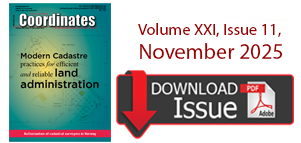August 2011: 7th International Symposium on Digital Earth,
23 – 25 August 2011, Perth, Australia, Perth, Australia, www.isde7.net;
NovAtel in collaboration with QinetiQ has developed GAJT (pronounced “Gadget”), the world’s first single-enclosure GPS anti-jam system small enough for light armored and other land-based military vehicles. GAJT combines NovAtel’s and QinetiQ’s outstanding technologies in a stand-alone, rugged enclosure that mounts to the exterior of vehicles. Intentional jamming of GPS can completely deny a position solution to users over a broad area. GAJT is a seven element controlled reception pattern antenna (CRPA) that nulls jammers, ensuring GPS positioning capabilities are retained during combat, training or other vehicle-based missions.
The United Nations Economic and Social Council (ECOSOC) voted to establish a committee of experts on global geospatial information management to coordinate international dialogue on spatial data infrastructures and enhance cooperation in that field. According to the latest report of the Secretary-General on global geospatial information management, the rapid technological advances in geospatial information and related technologies have made this kind of information readily available.
Astrium has been selected by the European Space Agency and the European Union as prime contractor for the Galileo Full Operational Capability Ground Control Segment. The contract value is 73.5 million euros. The Ground Control Segment (GCS) contract covers the provision of GCS facilities for the operation of the constellation of Europe’s global navigation satellite system. The contract, which will be led by an Astrium team out of the UK, covers the provision of a new facility at Fucino (Italy) and the expansion of the existing Ground Control Centre at Oberpfaffenhofen (Germany). The deployment also includes the provision of a temporary GCS back-up facility at the Fucino Galileo Control Centre for the four In-Orbit Validation satellites, and the provision of two further Telemetry, Tracking and Command (TTC) stations on Reunion and Noumea. Astrium’s unique expertise in ground systems has enabled them to be selected for all phases of the Galileo GCS development and implementation. Astrium was responsible for the development, installation and test of the GCS for the Galileo demonstrator GIOVE-B, launched in April 2008 and which is still successfully operating in-orbit.
The use of mobile apps by small businesses saved approximately USD 17.6 billion annually, estimates a survey conducted by the Small Business and Entrepreneurship (SBE) Council. The most popular type of application used was GPS navigation, with 68 percent, followed by apps for contact management at 46 percent and remote document access at 41 percent. Other popular kinds of apps included travel planning (32 percent), banking and finance management (30 percent), social media marketing (27 percent) and location-based services (23 percent).
The Space Applications Centre in Ahmedabad of the Department of Space of the Government of India recently selected the NavX®‐NCS Professional, a multi‐constellation and multi‐frequency GNSS RF navigation constellation simulator from IFEN GmbH, as the new reference simulator for its IRNSS development and testing. The IRNSS payload system engineering group of the Space Applications Centre (SAC) in
The Government of Vietnam selected Belgian consortium which is led by SPACEBEL, a software engineering company operating in the Space and Earth monitoring applications sectors, for its second microsatellite for earth observations, ‘VNREDSAT-1B’. Vietnam will develop this microsatellite through its VNREDSAT (Vietnam Natural Resources Environment and Disaster monitoring small Satellite) programme. SPACEBEL is in charge of the mission and system studies, design and development of the entire satellite software package as well as the development and deployment of the ground segment.

The Planning Commission, Government of India has floated the idea of the National GIS.
It has established an Interim Core Group (ICG) to prepare a blueprint for the development of the National GIS. With a vision to establish a national “GIS Platform” through an organizational structure of Indian National GIS Organization (INGO).

What has triggered the idea of National GIS?
The idea of National GIS (NGIS) has been driven by the needs of the Planning Commission, Government of India. The Planning Commission looks for lot of information which helps them in the process of planning. The need has been felt to integrate many of these information so that they can utilized effectively for various planning processes and applications.

Performance evaluation of the effect of QZS (Quasi-zenith Satellite) on precise positioning: Nobuaki Kubo, Tomoko Shirair, Tomoji Takasu, Akio Yasuda, Satoshi Kogure;
Need for new services in land administration: András Osskó;
Analysis of integrated navigation with GPS source variability:Mahmoud Efatmaneshnik, Yong Li, Allison Kealy, Andrew G Dempster










 (5.00 out of 5)
(5.00 out of 5)